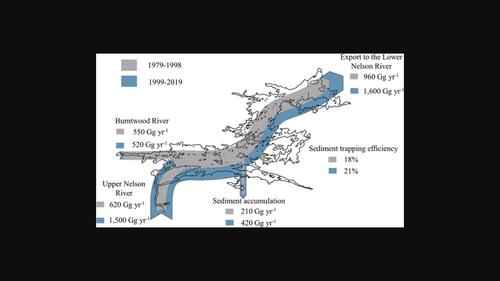当前位置:
X-MOL 学术
›
Hydrol. Process.
›
论文详情
Our official English website, www.x-mol.net, welcomes your
feedback! (Note: you will need to create a separate account there.)
Sediment sources and transport dynamics in large, regulated river systems with multiple lakes and reservoirs in the subarctic region of Canada
Hydrological Processes ( IF 2.8 ) Pub Date : 2022-08-15 , DOI: 10.1002/hyp.14675 Masoud Goharrokhi 1 , Gregory K. McCullough 2 , David A. Lobb 1, 3 , Philip N. Owens 1, 4 , Alexander J. Koiter 1, 3
Hydrological Processes ( IF 2.8 ) Pub Date : 2022-08-15 , DOI: 10.1002/hyp.14675 Masoud Goharrokhi 1 , Gregory K. McCullough 2 , David A. Lobb 1, 3 , Philip N. Owens 1, 4 , Alexander J. Koiter 1, 3
Affiliation

|
The Burntwood River (BR) and Upper Nelson River (UNR) are regulated rivers in the subarctic region of Canada. They merge at Split Lake and then discharge into Hudson Bay via the Lower Nelson River (LNR). The BR water discharge was increased eight-fold by a cross-watershed diversion in 1976. The UNR drains the 11th largest lake in the world, Lake Winnipeg, which itself receives discharge from a large North American Interior Plains watershed. Sediment loads and the source fingerprinting approach in these rivers were used to: (a) identify the sediment sources; (b) examine the impact of climate change and flow regulation on the BR and UNR sediment loads; and (c) assess the influence of Split Lake on downstream delivery of sediment into the LNR. Lake Winnipeg effectively decouples the UNR from the sediment sources in its prairie watershed. Fluvial riverbank and reservoir shoreline erosion in the UNR increased in the late 1990s, in response to a multi-decadal increase in discharge forced by climate change in the Lake Winnipeg watershed. The BR sediment load was increased seven-fold by diversion. Since diversion, flow regulation near the licenced limit has muted the response to variability in local precipitation and runoff; however, erosion processes independent from discharge (bank failures and subaerial processes) add variability in the sediment load record. Based on sediment budgeting, Split Lake conveys almost 80% of the BR and UNR sediment load into the LNR. The greater sediment load in the UNR (~1100 Gg year−1, compared to ~530 Gg year−1 from the BR) reveals that the UNR is the primary sediment source into the LNR, so that downstream sediment transport dynamics are more sensitive to the environmental changes in the UNR than to disturbances in the BR. Whether this may change in the future depends on changes in climate and engineering responses to increasing demand for hydroelectric power.
中文翻译:

加拿大亚北极地区具有多个湖泊和水库的大型受管制河流系统的沉积物来源和运输动态
伯恩特伍德河 (BR) 和上尼尔森河 (UNR) 是加拿大亚北极地区受管制的河流。它们在斯普利特湖汇合,然后通过下纳尔逊河 (LNR) 流入哈德逊湾。1976 年跨流域引水使 BR 的排水量增加了 8 倍。UNR 排放了第 11个世界上最大的湖泊,温尼伯湖,它本身接收来自北美内陆平原大流域的排放。这些河流的沉积物负荷和来源指纹方法用于: (a) 识别沉积物来源;(b) 检查气候变化和流量调节对 BR 和 UNR 沉积物负荷的影响;(c) 评估斯普利特湖对下游沉积物进入 LNR 的影响。温尼伯湖有效地将 UNR 与其草原流域的沉积物源分离。1990 年代后期,由于气候变化迫使温尼伯湖流域的排放量增加了数十年,UNR 的河流河岸和水库海岸线侵蚀加剧。BR 沉积物负荷因改道而增加了七倍。自从分道扬镳以来,接近许可限制的流量调节减弱了对当地降水和径流变化的响应;然而,与排放无关的侵蚀过程(堤岸倒塌和地下过程)增加了沉积物负荷记录的可变性。根据沉积物预算,Split Lake 将近 80% 的 BR 和 UNR 沉积物负载输送到 LNR。UNR 中更大的沉积物负荷(~1100 Gg 年-1,与来自 BR 的~530 Gg 年-1相比)表明 UNR 是进入 LNR 的主要沉积物来源,因此下游泥沙输送动态对 UNR 的环境变化比对 BR 的干扰更敏感. 这在未来是否会改变取决于气候变化和工程对水电需求增加的反应。
更新日期:2022-08-15
中文翻译:

加拿大亚北极地区具有多个湖泊和水库的大型受管制河流系统的沉积物来源和运输动态
伯恩特伍德河 (BR) 和上尼尔森河 (UNR) 是加拿大亚北极地区受管制的河流。它们在斯普利特湖汇合,然后通过下纳尔逊河 (LNR) 流入哈德逊湾。1976 年跨流域引水使 BR 的排水量增加了 8 倍。UNR 排放了第 11个世界上最大的湖泊,温尼伯湖,它本身接收来自北美内陆平原大流域的排放。这些河流的沉积物负荷和来源指纹方法用于: (a) 识别沉积物来源;(b) 检查气候变化和流量调节对 BR 和 UNR 沉积物负荷的影响;(c) 评估斯普利特湖对下游沉积物进入 LNR 的影响。温尼伯湖有效地将 UNR 与其草原流域的沉积物源分离。1990 年代后期,由于气候变化迫使温尼伯湖流域的排放量增加了数十年,UNR 的河流河岸和水库海岸线侵蚀加剧。BR 沉积物负荷因改道而增加了七倍。自从分道扬镳以来,接近许可限制的流量调节减弱了对当地降水和径流变化的响应;然而,与排放无关的侵蚀过程(堤岸倒塌和地下过程)增加了沉积物负荷记录的可变性。根据沉积物预算,Split Lake 将近 80% 的 BR 和 UNR 沉积物负载输送到 LNR。UNR 中更大的沉积物负荷(~1100 Gg 年-1,与来自 BR 的~530 Gg 年-1相比)表明 UNR 是进入 LNR 的主要沉积物来源,因此下游泥沙输送动态对 UNR 的环境变化比对 BR 的干扰更敏感. 这在未来是否会改变取决于气候变化和工程对水电需求增加的反应。











































 京公网安备 11010802027423号
京公网安备 11010802027423号